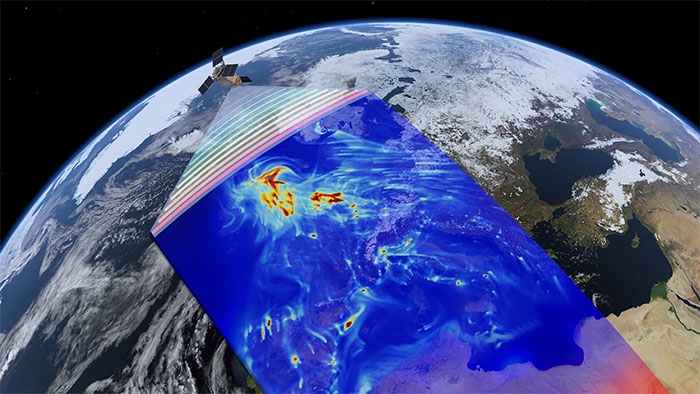For the first time, the satellite detected and measured pollution gas leaks
For the first time a global air pollution monitoring satellite has detected and measured the amount of methane leaking from an explosion of a gas well in Ohio.
Scientists say this could be an important tool in efforts to limit climate change.
This important finding by a group of American-Dutch scientists was published on December 16 in the Proceedings of the National Academy of Sciences.
Important findings

Sentinel-5P satellite with the TROPOMI tool - (Photo: ESA)
For a long time, oil well explosion has emitted a large amount of methane, the second largest after CO2 contributing to global warming. Measuring these leaks has also become a challenge for scientists.
In October 2017, the European Space Agency (ESA) launched Sentinel-5P satellite with the convection floor monitoring tool (TROPOMI) into orbit to begin the mission of mapping gases such as nitrogen dioxide. , methane, carbon monoxide, carbon dioxide . on cities and industrial areas that the satellite travels from Europe, Asia to Africa and the Americas.
According to the New York Times, TROPOMI made an astonishing discovery: an obscure oilfield explosion in Ohio in February 2018 was in fact one of the largest methane leaks ever recorded at America.
The explosion at a natural gas well, operated by a subsidiary of ExxonMobil, in Belmont County (Ohio) released more methane than the entire oil and gas industry of countries like Norway and France for a year. It is estimated that the methane released from the well must be up to 120 tons / hour, double the amount of methane leak in the Aliso Canyon gas well in California in 2015.
TROPOMI was able to observe a gas well in Ohio on the 13th day after the explosion and calculate changes in pressure and the rate at which the well escaped methane. As a result, ExxonMobil had to fill a well in Ohio nearly three weeks after the explosion that caused a methane leak.
Scientists say the new findings reinforce the view that methane leaks in accidents of this type are often difficult to predict and are much larger than previously thought.
Quickly fix the consequences
In the past, satellites had to localize their targets carefully so they could detect leaks like the Aliso Canyon well. However, TROPOMI discovered a methane leak in Ohio as part of a routine patrol operation.
According to the research, to combat climate change and build a low carbon economy, being able to accurately monitor greenhouse gas emissions is a prerequisite.
The team said the study indicated that the amount of methane leaked from major accidents in the oil and gas industry may not be taken into account, affecting the annual estimates of the United Nations Framework Convention on Change. climate.
The team said an important task now is to quickly screen tens of millions of data points that the satellite collects every day to identify hot spots for methane leaks. Research focusing on oil and gas fields in the United States also shows that a small number of locations are responsible for the majority of methane emissions in the region.
Steven Hamburg, chief scientist of the Environmental Protection Fund (EDF) and a co-author of the study, said the findings "have opened up opportunities to detect, measure and evaluate cases." methane leaks and helps people take timely remedies. "
- China's first comprehensive environmental monitoring satellite
- Earth often leaks plasma out of space
- The incredible amount of oil leaks into the sea
- Beijing must change its way of measuring pollution because of pressure
- Satellite images reveal the disaster of Chinese air pollution
- Electric waste like global time bomb
- The season also star
- Satellite images detected 1,000 dangerous points on the central highway
- How much human waste has been discharged into space?
- We are about to measure pollution at home
- Beijing for the first time warned about air pollution
- Smoke from China began to spread to Vietnam
 Is the magnetic North Pole shift dangerous to humanity?
Is the magnetic North Pole shift dangerous to humanity? Washington legalizes the recycling of human bodies into fertilizer
Washington legalizes the recycling of human bodies into fertilizer Lightning stone - the mysterious guest
Lightning stone - the mysterious guest Stunned by the mysterious sunset, strange appearance
Stunned by the mysterious sunset, strange appearance